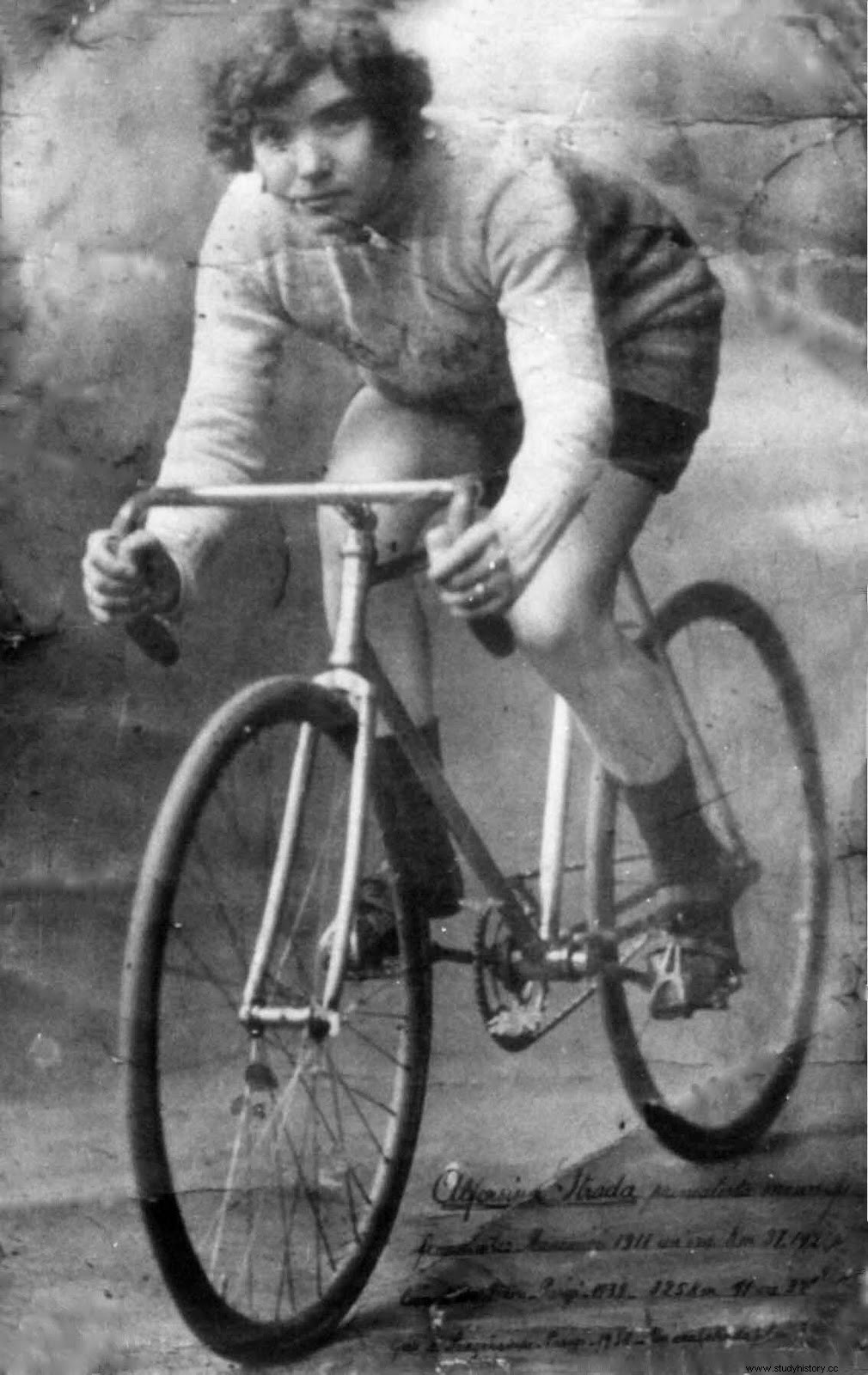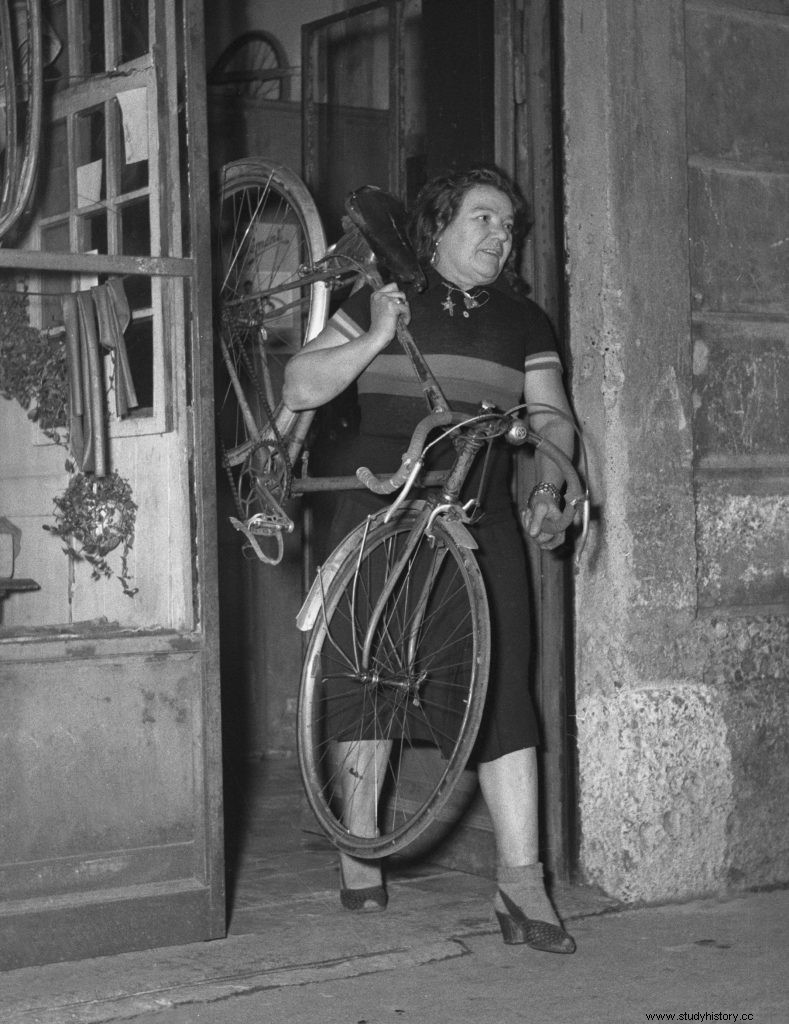Pioneer of women's cycling, Alfonsina Strada (1891 – 1959) completed the Giro d'Italia in 1924 in an all-male peloton; she is the only woman to have officially participated in this race and one of the three great men's cycling tours.
The Freedom Machine

The origins and childhood of little Alfonsina Morini, born on March 16, 1891 in Castelfranco Emilia in northern Italy, have been so romanticized by the press that it becomes difficult to distinguish the true from the false. However, it is certain that the girl grew up in a large and modest family. Her mother is a nurse and her father a farmer and she is, according to the stories, the second of a family of 8 or 10 children. Legend has it that the children grew up in a very rudimentary house accommodating 24 people, and surrounded by chickens.
When Alfonsina turns ten, her father trades some chickens for the village doctor's old bicycle. For the young child, who spends her days playing with her brothers and their friends and who is considered a tomboy, it is love at first sight and the beginning of a great adventure. On her “freedom machine”, as she calls it, Alfonsina pedals through the countryside, including on Sundays when her parents believe her at mass.
At the time, and despite reluctance and judgement, the bicycle attracted more and more women with the freedom of movement and independence it offered. So much so that the American suffragist activist Susan B. Anthony said in 1896:“the bicycle has done more for the emancipation of women than anything in the world. » Although very young, Alfonsina clearly sees in this new object the opportunity to push the limits and reject stereotypes. The hobby, initially accepted by her family, ends up being condemned and even considered scandalous, to the point that she is nicknamed "the devil in petticoats".
First races
It takes more to discourage the intrepid Alfonsina who, at the age of 13, decides to the great despair of her parents to compete in races, including men's. Quickly, she wins a first race – the prize of which is a live pig -, then a second; she dominates women's competitions, and does not hesitate to face male runners. By dint of victories, she forged such a reputation that in 1909, the Italian federation would have invited her to an exhibition race in Russia, in front of Tsar Nicolas II. In 1911, aged twenty, Alfonsina broke the women's one-hour distance record by covering 37.192 km.
Despite her successes, Alfonsina's conduct, at a time when female sports practice was condemned, was often considered scandalous and her parents tried to make her give up cycling. When a suitor, Luigi Strada, a welder, shows up, they entice him to marry in the hope that a nuptials will entice him to put his bicycle away in the garage. Alfonsina Morini thus became Alfonsina Strada in 1915. To the great displeasure of his parents, however, Luigi has no intention of getting in the way of his wife's passion for sport, on the contrary:as a wedding present, he gives her a bike he made himself and then becomes her trainer.
In Milan where the couple settled, Alfonsina Strada trains seriously and participates in competitions in Italy, France, Luxembourg, in essentially male races. In 1917, she participated in the Tour of Lombardy, a prestigious and difficult race. Of the 54 participants on the starting line, only 31 cross the finish line; Alfonsina is one of them, and finishes 29 e . The following year, she finished 21 e .
The Giro d'Italia
In 1924, the Giro d'Italia, the Tour of Italy, went through a crisis which turned out to be an opportunity for Alfonsina Strada. A conflict opposes the race director, Emilio Colombo, to the major professional cycling teams who are demanding compensation. Emilio Colombo then decides to open the race to independent runners. Alfonsina takes the opportunity and registers among the 90 participants, noted under the name "Alfonsin". She was then the first – and to date the only – woman to officially participate in one of the three great men's cycling tours (Tour de France, Tour of Italy, Tour of Spain). She is also the first to compete in a stage race and many believe that she will not last longer than one stage.
Alfonsina quickly disabuses them and proves that she has her place in the race. During the first stages, she finished before many competitors and won the hearts of the crowd, who sometimes carried her in triumph once they crossed the finish line. In the Gazetta dello Sport, Emilio Colombo writes:"in just two steps, the popularity of this little girl has become greater than all the missing champions put together" . The 78 th stage, which takes place in too complicated weather conditions, however costs him his classification:Alfonsina falls, breaks his handlebars and injures his knee; bruised, she completes the next stage out of time. The cyclist having become the darling of the crowd, Emilio Colombo decided, in order not to harm the media success of the race, to let her continue despite everything - and to bear her expenses - while excluding her from the classification.
Alfonsina's popularity is undeniable during the following stages, where she is sometimes as much acclaimed as the winner of the stage. She starts with the other competitors, but no longer appears in the rankings. Finally, she completes a race finished only by 30 of the 90 initial competitors. Determined to take revenge, Alfonsina asks to compete in the next edition, but this new participation will be refused. The conflict between the professional teams and Colombo has ended, and the latter no longer needs the cyclist to restore the image of his race. No more women will participate.
End of career
Alfonsina Strada continues to compete in competitions and exhibition races. During her career, she won all her women's races, but also 37 races ahead of male riders. Widowed in 1946, the cyclist remarried four years later to Carlo Messori, a retired cyclist. Both open a store for the sale and repair of cycles in Milan. Aged 59, Alfonsina maintains a connection with her passion through the store and by continuing to travel daily by bicycle. Widowed again seven years later, the cyclist knows a solitary and painful life.

When she becomes too tired to continue riding her bike, Alfonsina sells medals and trophies from her glorious past to buy a motorcycle, thanks to which she now joins the public of cycle races. In September 1959, at the age of 68, Alfonsina left on a motorbike to attend the tour of the Three Vares Valleys. A race that makes her want to go for a bike ride again, as she tells her concierge once she returns home. She then decides to take her motorcycle back to the store to pick up her bicycle. It was then that the machine tipped over, and fell on him. Alfonsina Strada then died of a heart attack before arriving at the hospital.
